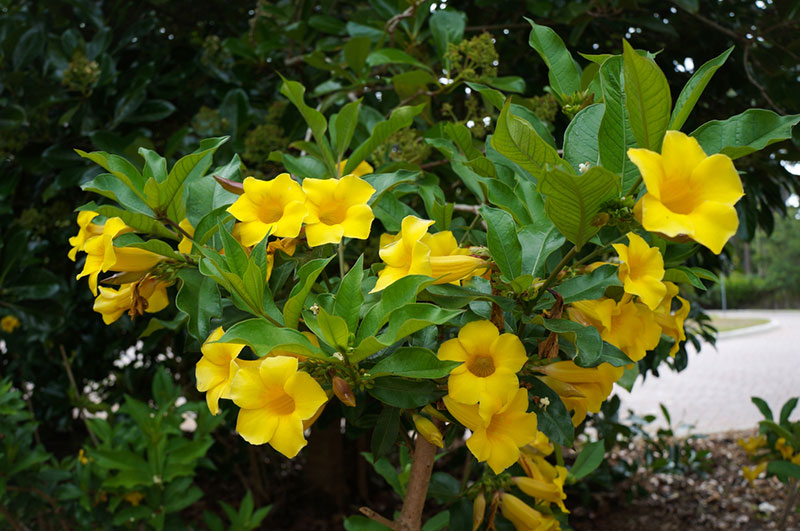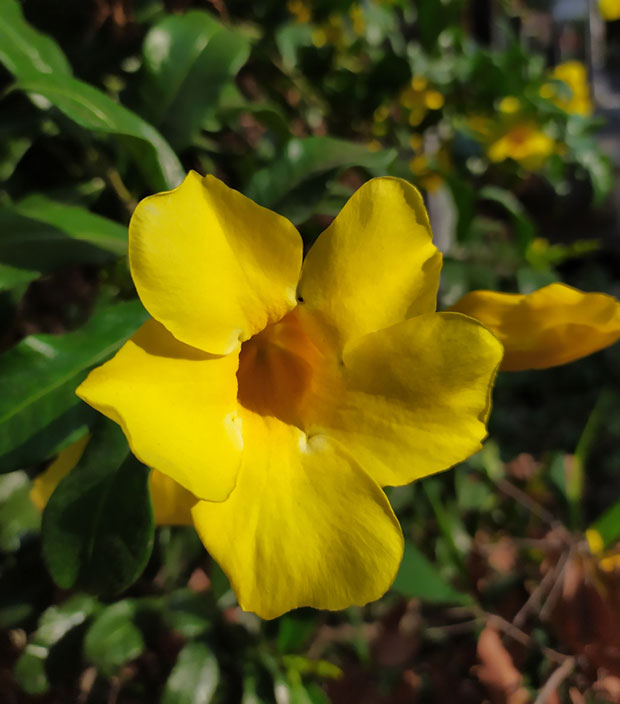
Bush allamanda has green, glossy leaves and bright yellow blooms that have a darker throat than the rest of the flower. These flowers are four to five inches across, and they can be seen on the plant from early summer until as late as November or December in warmer states, like Florida.
The bright color and the scent of these bell-shaped flowers will also attract pollinators to your garden.
Bush allamanda is a tropical plant that needs tropical conditions to thrive, which includes warmth and moisture during the growing season. It is easy to care for, and once it is mature, it should be about five feet in height. The plant will grow outdoors in hardiness zones 10 and above.
| Origin: | Brazil |
| Botanical Name: | Allamanda schottii |
| Plant Type: | Shrub |
| Light: | Full Sun |
| Watering: | Average |
| Temperature: | Above 40 degrees Fahrenheit |
| Height: | 4 – 5 feet |
| Spread: | 4 – 5 feet |
Let’s take a look at some of the specific requirements to care for this plant.
Light and Temperature Requirements
Bush allamanda is a plant that needs a lot of light to grow. It can do great in full sun, but it can also grow indoors with filtered light that does not hit the plant directly. The more sun the plant gets, the darker the leaves will be. In addition, the plant will create more blooms during the blooming season.
This is a drought-tolerant plant that likes to grow in humid conditions. Make sure to keep the temperature where the plant grows, above 40 degrees Fahrenheit. If you live in an area where the temperature could drop below this point, make sure to bring the plant indoors.
Watering Requirements
Typically, this is a plant that requires an average amount of water, but during the summer months, it may require a bit of extra water to make sure that the plant blooms properly and flower loss does not occur.
In the winter, you may want to reduce the amount of water that the plant gets without letting the roots dry out. This is very important because this plant does like to have a bit of moisture to grow.
Distilled water or rainwater is best for this plant because it can be sensitive to water that has too much calcium in it.
Soil and Fertilizer Requirements
Bush allamanda will grow best in fertile, well-draining soil. It will grow in most types of soil, but it will thrive in a peat-based soil that is rich with nutrients. As far as fertilizer, this plant will require a weak fertilizer to be given to the plant once a month or so. In the summer, it can be given to the plant twice a month to help encourage the plant to grow and bloom.

Pruning and Propagation Tips
Pruning this plant is a great way to control the look of the allamanda as well as encourage new growth. It can be pruned every year, and it is best done before the spring of the year when the plant grows.
If you decide to prune the plant during the growing season, the blooms could be affected because the flowers grow in clusters. Once the plant is mature, pruning will not be needed as much. New plants can be grown from stem cuttings that you take from an existing plant.
Pests and Diseases
If the plant leaves turn brown and begin to curl, aphids are most likely living on the plant. If the leaves start to drop, spider mites could be the reason. To get rid of both of these infestations, you can wipe the foliage clean with warm water and gentle soap. If the leaves look wilted, the plant may not be getting enough water. However, too much water can also lead to root rot.
Planting Location Tips
- The allamanda bush is an excellent medium-height shrub that can be used to camouflage things that you don’t want to be seen in your garden.
- It will make a great corner accent for your house.
- They need to be planted about three feet from other plants.
- These will do great in sunrooms and greenhouses.
- Keep the plant away from cold drafts.
Frequently Asked Questions
How big does a bush Allamanda get?
The Allamanda bush can grow to 4-5 feet tall and wide.
When should I prune a bush Allamanda?
It can be pruned yearly, and it is best done before Spring.
Can you grow bush allamanda indoors?
Yes! They require bright direct sunlight indoors.




